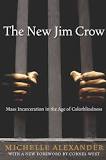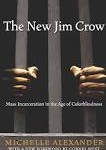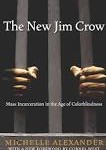 Welcome to the 6 month study group on Michelle Alexander’s The New Jim Crow: Mass Incarceration in the Age of Colorblindness. All comments are screened. Disagreement is fine. Incivility will not be tolerated. Subscribing via RSS and subscribing to comments is recommended. You may join the group at any time.
Welcome to the 6 month study group on Michelle Alexander’s The New Jim Crow: Mass Incarceration in the Age of Colorblindness. All comments are screened. Disagreement is fine. Incivility will not be tolerated. Subscribing via RSS and subscribing to comments is recommended. You may join the group at any time.
For more information please read this linked post. Discussion on the Introduction and Chapter One is here. Chapter Two discussion is here.
———————————————
The two stories that begin Chapter Three are heartbreaking. The first starts off the inaugural post to this study group and can be read there.
Here is the second:
“…place yourself in the shoes of Clifford Runoalds, another African-American victim of the Hearne drug bust. You returned home to Bryan, Texas, to attend the funeral of your eighteen-month-old daughter. Before the funeral services begin, the police show up and handcuff you. You beg the officers to let you take one last look at your daughter before she is buried. The police refuse. You are told by prosecutors that you are needed to testify against one of the defendants in a recent drug bust. You deny witnessing any drug transaction; you don’t know what they are talking about. Because of your refusal to cooperate, you are indicted on felony charges. After a month of being held in jail, the charges against you are dropped. You are technically free, but as a result of your arrest and period of incarceration, you lose your job, your apartment, your furniture, and your car. Not to mention the chance to say goodbye to your baby girl.”
– Michelle Alexander
Clifford Runoalds is but one face of mass incarceration. There are too many like him, and too many like Emma Faye Stewart, whose children were taken from her because she pled guilty to a crime she did not commit in order to get back to those same children more quickly. Both of these faces are African American. That is no accident.
There is a system at play.
All the pieces of this puzzle affect those caught in its pattern, whether they are in prison or out. Whether they have committed a crime or not. Whether the judgement that something is a crime seems just or unjust.
A large percentage of those imprisoned by the US today are not violent offenders. Most are black or brown, yet the Supreme Court does not allow hearings that challenge racial bias even though the system is built upon racial bias.
Stop and Frisk is the first step.
“if police start stopping and frisking hundreds of thousands of white women and men in the manner they’ve been searching young men of color, they will undoubtedly issue some summonses and make some arrests. There are middle-class white people in possession of illegal guns—not to mention heroin, illegal prescription painkillers, and marijuana. The success rates may not be high. But this shouldn’t deter police officials. After all, low success rates haven’t dissuaded them from searching young men of color for contraband and firearms.” – Christopher E. Smith
The second step comes after arrest and is where the concept of “colorblindness” comes in. Any defendant that wants to use racial bias to bolster his case must prove in advance that “racial disparities are the product of intentional racial discrimination – ie, the work of a bigot.”
Racial bias in the age of colorblindness rarely looks like the bigots of old. These days, it comes in the form of systems.
Systemic racism arises from a network of biases, assumptions and tropes.
These biases infect us from many sources, including our upbringing, what stories get told in the news and how, what the dominant culture values and is used to, and who appears in movies and on the mainstream music awards, or what images and language portray good or evil, beauty or menace.
Let us examine our own biases. How do we feel when someone is coming toward us on the sidewalk wearing a sweatshirt with the hood pulled up? Or has skin darker than our own? Or wears baggy pants? Or speaks with a different cadence?
We are awash in cultural signifiers. We are entrained to read the signifiers we are most familiar with. We seek those out, school ourselves in their changing fashions, and shun the unfamiliar. Sometimes the shunning is simply a dismissal, a matter of taste. But how was that taste formed? Do we even ask that question?
Even those who can read the signifiers of baggy pants and hooded sweatshirts may still preference other cultural tropes. Why? Because the overculture makes certain every single person is awash in those tropes. They are almost inescapable.
Because of our entrainment, the shunning of the unfamiliar can also carry a whole host of judgements and opinions that become linked to irrational fears.
Irrational fears make us dangerous to one another.
One product of those irrational fears is our current mass incarceration system.
The criminal justice system and mass incarceration have systemic racism as their foundations. We can’t think in terms of “bad people” whether we are speaking about police officers or the incarcerated. We need to begin thinking in terms of “bad systems.”
We need to examine our relationship to these bad systems. How do they play on us, and what roles do we play that uphold them?
———————————
Here are some questions to guide our discussion of Chapter Three:
1. License to Discriminate
The U.S. Supreme Court has made it virtually impossible to challenge racial bias in the courts at any stage of the criminal justice process, from stops and searches, to plea bargaining and sentencing. In some ways, this situation is reminiscent of Plessy v. Ferguson, which embraced the “separate but equal” doctrine and protected the old Jim Crow regime from legal challenge. What can be done to expose and challenge racial bias in the system if the Supreme Court won’t address it? Can the strategies of earlier movements be a guide, or are new approaches necessary?
2. Violence
Relatively little is said in these chapters about violent crime. The focus is the War on Drugs. Alexander explains that, although half of state prisoners are violent offenders in some states, that statistic can be misinterpreted. Violent offenders typically receive much longer sentences than non-violent offenders, who receive shorter sentences but cycle in and out of the system. She emphasizes that what matters most is the prison label, not prison time. Of the nearly 7.3 million people under correctional control, 1.6 million are actually in prison. The rest are in jail or on probation or parole. More than 50 million people have been labeled criminals and felons and are subject to legal discrimination for the rest of their lives. Only a tiny percentage of these are violent offenders, yet this massive system is justified as a necessary means of dealing with people our society fears.
- Do you believe that legitimate fears about violence play a larger role in public support for mass incarceration than is acknowledged here? Is it possible to build a movement to end mass incarceration in communities plagued by violent crime without offering solutions to the violence that threatens people’s basic security?
- Does focusing on the War on Drugs and non-violent offenders send the message that it is permissible to shame, dehumanize, and marginalize people so long as they’re classified as violent? Should the movement to end mass incarceration offer hope of rehabilitation, redemption, and restoration to violent offenders as well as non-violent offenders?
- Cities like Chicago and New Orleans have the highest incarceration rates in the world yet are plagued by high levels of violent crime. Should the movement to end mass incarceration be linked to demands for quality education and jobs? Or is it important for the movement to have a sharper, narrower focus?
3. Diversity and Punitiveness
Research conducted by The Sentencing Project, an organization that advocates for alternatives to incarceration and promotes reforms in sentencing policy, shows that the countries that are the most racially and ethnically diverse are the most punitive, whereas the most homogeneous countries are the least punitive. Why do you think that is?
To close, watch John Oliver and some puppets on the topic of mass incarceration. A little something to pass along to your friends.














